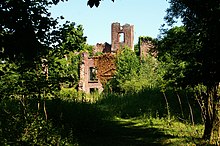Bleijenbeek Castle
Bleijenbeek Castle , also often spelled Blyenbeck in German , is a ruined castle in the Afferden district of Bergen in the Dutch province of Limburg .
history
In 1405, Wijnand Schenck van Nijdeggen is the owner of Bleijenbeek Castle. It remained in the possession of the noble Nideggen family for the next two centuries. Martin Schenk von Nideggen , who had made it to army commander in Spanish and Dutch services, resided there. In 1589, during the Eighty Years War , the castle was occupied by the Spanish.
In 1708 the property , which had meanwhile been converted into a moated castle , came into the possession of the Counts of Hoensbroech by inheritance .
When the Jesuits were expelled from Germany by virtue of the Jesuit laws from 1872 as part of the Kulturkampf , the owner, Count Franz Egon von Hoensbroech (1805–1874), the father of the later ex-Jesuit and Jesuit critic Paul Graf von Hoensbroech , placed the country palace in this order available as asylum. The famous priestly writer Joseph Spillmann lived there, among others , who processed the story of Bleijenbeek and its former residents, the taverns of Nideggen, in the story The Paradise Room.
The facility included the tea house ( theehuisje ) by a pond. The castle was destroyed by a British bombing raid in February 1945. The ruins of the outer walls have been preserved.
The moat around Bleijenbeek Castle is leased by the local fishing club HSV de voorn Afferden and is home to a rich population of freshwater fish.
Bleijenbeek in literature
Joseph Spillmann describes Bleijenbeek in the introduction to his story Das Paradieszimmer 1885 as follows:
“ From the town of Goch the path leads through fertile fields westwards to the Dutch border. The old Augustinian monastery of Gaesdonk can be easily reached in just an hour . Immediately behind Gaesdonk, a stream forms the border between Prussia and Holland. We have not yet covered a thousand paces over this, so the fertile soil ceases and quickly turns into desolate heathland. Then, interrupted here and there by sand dunes and swamps , the heather stretches for almost two hours to the lower banks of the Meuse . Approximately in the middle of this barren area stands Bleijenbeek Castle, a real Dutch castle, surrounded by wide moats, which were its strength in ancient times. The castle garden, which reflects its dark yew walls and fresh green arcades, its shady linden and horse chestnut trees in the wide expanse of water of the moat, is much more beautiful than the hiker should expect after the tiring walk through the heather. The old castle house with the weathered brick walls, the huge slate roof and the square central tower has still retained its stately appearance. A wide stone bridge leads from the south side over the almost pond-like, outer moat. The outer courtyard is now surrounded on three sides by the rentier, a tenant apartment and economic buildings, while the castle building occupies the fourth side. This (the manor house) is again surrounded by a wide ditch, which is now dry and is partly planted with flowers and ornamental shrubs. A second bridge leads over it to the castle portal. The castle building forms a massive square with a narrow inner courtyard surrounded by arcades , from which the tower, half built into the northern main wing, rises to a moderate height above the massive roofs. "
literature
- Joseph Spillmann : Das Paradieszimmer , story in the anthology Wolken und Sonnenschein , Herder Verlag, Freiburg, 1925, new edition by Father Engelbert Recktenwald, 69518 Abtsteinach, 2010 (without ISBN)
Web links
- Ruïne Bleijenbeek In: afferden-limburg.nl (Dutch)
Individual evidence
- ^ Genealogical page on Paul von Hoensbroech
- ↑ Website of the St. Georgen University of Applied Sciences, Frankfurt (on Bleijenbeek in Chapter 1.3)
Coordinates: 51 ° 38 ′ 9.3 ″ N , 6 ° 3 ′ 10.3 ″ E



